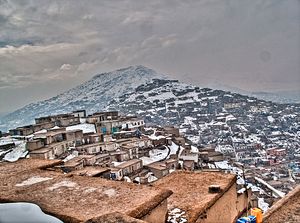Afghanistan has recently been the scene of a debate on what the real name of one of its official languages is. Afghanistan has two official languages, Pashto and Dari. However, most Dari speakers natively call their language Farsi or Persian. According to Radio Free Europe, the dispute over the name of the language was “reignited after the BBC changed the name of one of its local-language Facebook pages to BBC Dari, prompting a backlash from many Afghan Persian speakers who despise the word officially used to describe their language.”
Strangely, the Persian language, official in three countries — Iran, Afghanistan, and Tajikistan — and spoken in many others, such as Uzbekistan, Iraq, Azerbaijan, Bahrain, and Pakistan, does not have this sense of unity, despite all of its forms being mutually intelligible and based on the same literary standard and cannon dating from the early Middle Ages. As a result, the Persian language is called Farsi in Iran, Dari in Afghanistan, and Tajik in Tajikistan.
This has led many to believe that the three aforementioned languages are actually separate, though albeit closely related languages, and in fact, not the same language. This author has always found it odd when looking through language options on U.S. government websites and paperwork to see Persian (Farsi) and Dari listed as separate languages; it would almost be like listing American and British English as separate languages.
On the other hand, the Arabic language, official in 28 countries across Africa and the Middle East, is really a collection of languages, some not even mutually intelligible. Yet, a standardized form of the language prevails across all Arabic-speaking countries, which all proudly acknowledge they all speak the same language, Arabic.
The reason for this is that unlike the Arab identity and language, which was promoted by a strong post-colonial pan-Arab movement in several nations, the Persian-speaking nations all went their own ways for political reasons. The Pahlavi Dynasty of Iran (1925-1979) strongly emphasized Iran’s pre-Islamic identity and connection with ancient Persia. On the other hand, Soviet authorities in the Tajik Soviet Socialist Republic sought to distance Central Asian Persian speakers from the ancient Persian and medieval Islamic identity of their ancestors, and changed the script of the Tajik language from Perso-Arabic to Cyrillic. Meanwhile, while speakers of Afghan Persian (Dari) are over half the population of Afghanistan, they are divided between several ethnic groups, such as the Tajiks, Farsiwan, Hazara, and the Aimaq; the single largest ethnic group in Afghanistan are the Pashto speaking-Pashtuns, also historically known as the Afghans.
As the name of the country suggests, Pashtuns or Afghans, were the historically dominant ethnic group in the country, which was created by Pashtun kings in several stages from 1709 to 1747. The country is still mostly dominated by political organizations made up mostly of Pashtuns, including the Taliban, as well as the support-bases of both Hamid Karzai and Ashraf Ghani.
Because of the dominance of the Pashtun in Afghanistan, there have been many attempts to separate Afghanistan’s identity from Iran’s. Persian speakers in the country say “the term Dari has been forced on them by the dominant Pashtun ethnic group as an attempt to distance Afghans from their cultural, linguistic, and historical ties to the Persian-speaking world.”
There is also much resentment on the part of Afghan Persian speakers over Pashtun efforts to shape the vocabulary of Afghan Persian in a manner that would differentiate it from Iranian Persian. For example, many in Afghanistan insisted that the Pashto word for university, pohatun (پوهنتون) also be used in Persian-language signage, instead of the Persian word, daneshgah (دانشگاه).
The Persian language in Afghanistan was officially renamed Dari in the country’s 1964 constitution, and the practice has since persisted. Dari is a medieval synonym for Persian that means “language of the court” as the Persian language was widely used in princely courts in the eastern Islamic world. According to a drafter of that constitution, “Afghanistan’s Pashtun leaders wanted Pashto as the sole official language, claiming that Farsi belonged to Iran. To ensure equity between Pashto and Farsi, Persian speakers opted to include the name Dari to make a superficial distinction.”
The issue still deeply polarizes Pashtuns and non-Pashtuns, and reflects a north-south political and cultural divide in Afghanistan. The best solution would be one that changes the name of the Persian language in Afghanistan via constitutional means to one that reflects its speakers’ own identity. There is hardly any risk that such a change, renaming Dari as Farsi, would pose a threat to Afghanistan’s sovereignty or identity. After all, most Persian-speakers (and leaders) in Afghanistan are Sunni, not Shia, and have strong local identities and concerns deeply rooted in their localities and fiefs; their geopolitical horizons are often more closely oriented toward South Asia or Central Asia than Iran, with the exception of Herat in the far-west.

































